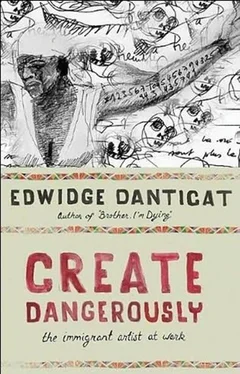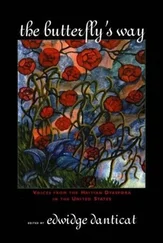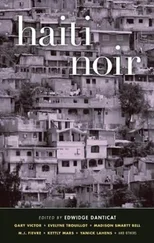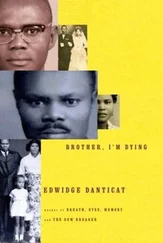In this essay, however, I can’t help but think of Jean’s reaction to my, in retrospect, inconsequential dyaspora dilemma, in a conversation we had when I visited his radio station to discuss a Creole program that Jonathan had created from one of my Haiti-based short stories, a radio play about a man who steals a hot air balloon to fly away from Haiti. Translating-retranslating-that story from the original English in which I had written it had been a surreal experience. It was as if the voice in which I write, the voice in which people speak Creole that comes out English on paper, had been released and finally I was writing for people like my Tante Ilyana, people who did not read, not because they did not have enough time or because they had too many other gadgets and distractions, but because they had never learned how.
Now I am suddenly back in the old essay, back to bowing my head in shame at being called a parasitic dyaspora , a foreign being but still not a blan , and I want to bring the old essay into this one with these words from Jean: “The Dyaspora are people with their feet planted in both worlds,” he said. “There’s no need to be ashamed of that. There are more than a million of you. You all are not alone.”
Having been exiled many times himself to that very dyaspora that I was asking him to help me define, Jean could commiserate with all of us exiles, émigrés, refugees, migrants, nomads, immigrants, naturalized citizens, half-generation, first-generation, American, Haitian, Haitian American, men, women, and children who were living in the United States and elsewhere. Migration in general was something he understood well, whether from the countryside-what many in Haiti called the peyi andeyò , the outside country-to the Haitian capital, or from Haitian borders to other shores.
Jean’s funeral was held at the Sylvio Cator soccer stadium in downtown Port-au-Prince, where thousands streamed by his coffin and the coffin of Jean Claude Louissaint, a watchman at the radio station who was gunned down in the radio station’s parking lot along with Jean. T-shirts with Jean’s face had been distributed and everyone, including his wife, daughters, and sisters, wore them at the stadium that day. Banners demanding justice for the murders lined many Port-au-Prince streets and graffiti expressing similar sentiments covered the walls of government buildings. At the stadium ceremony, Jean received a posthumous service medal from the Haitian government. But his real funeral was held a week later in the Artibonite Valley, where as a young man he had worked as an agronomist. There his ashes were scattered in Haiti’s largest river, at the heart of the country’s breadbasket. The ashes were scattered by his wife, Michèle, along with several peasant organization leaders he had befriended over the years.
In her memoir, Mémoire errante , Jan J. Dominique, the novelist and radio personality who is Jean Dominique’s daughter and phonetic namesake, writes of the Artibonite Valley ceremony that during Jean’s wake she witnessed the creation of a myth when someone told Jean’s wife, Michèle, “You know, Madame Jean, he often came to see us. He would follow us across the river all the way to the coffee plantations high in the mountains. He would sleep with us, share in our way of life. He was just here, a month ago.”
“Michèle looked over at me,” noted Jan J. “I am bewildered. My father has never lived, in recent years, in this region. He had not left Port-au-Prince last month. When he went to the Artibonite it was to work as a journalist and activist. He neither planted nor harvested in the fields. We do not correct this man. We had not yet even scattered my father’s ashes in the river when he had already become a legend.”
I remember watching footage of the scattering of Jean’s ashes, which were passed in a corn-husk-covered calabash from his wife’s trembling hands to that of several local farmers before they were emptied into the slow-moving water. I remember thinking how ample they were, these bountiful ashes, for such a skinny man.
The footage of the scattering of the ashes is now part of a documentary that Jonathan Demme was directing about Jean’s life. The documentary would be titled The Agronomist because, during one of the many interviews that Jonathan conducted with Jean-when Jonathan had envisioned a film that would end with Jean’s triumphant return from exile-Jean, who is often referred to as Haiti’s most famous journalist, told Jonathan, “You will be surprised, but I am not a journalist. I am an agronomist.”
Jean had been dead for eight months, and the Haitian government’s investigation into his death had been going nowhere, when I met his widow, Michèle Montas, in a Manhattan restaurant in December 2000 to interview her for an article I was writing about the case for The Nation magazine. Michèle was indeed guapa , a tall, striking, usually cheerful woman, but the day we met to talk about Jean’s death in detail for the first time, she was looking just as sad as she had at his funeral months earlier. At lunch, she barely sipped her water. When the waiter came to check on her glass, he stopped to ask about a button pinned to her jacket. On the button was a picture of Jean. Above Jean’s piercing eyes, raised eyebrows, and high forehead were the words Jean Dominique vivan (Jean Dominique Lives).
“Who is Jean Dominique?” the waiter asked Michèle.
“My husband,” she said.
For more than two decades, excluding stretches of time when they were twice forced into exile, the two had worked together, coanchoring a morning news program, the highlights of which were Dominique’s commentaries on Haitian social and political life. Friends and foes listened to them, to “smell the air and test the waters,” as Jean liked to say, “get closer to the beton ,” gauge the mood of the streets. Had it been any other morning, Jean and Michèle would have been together when he and Jean Claude Louissaint were assassinated in the radio station’s parking lot.
“We usually drove to work together,” Michèle explained, carefully drawing out her words, as though to pace herself so she would not cry. “That morning, Jean left ten minutes before me to look at some international news for the program. As I got in the car, leaving home, I heard some usual announcements on the radio and then silence. I called the station and the person who answered told me, ‘Just come!’ When I pulled into the parking lot, the police were there. I saw Jean Claude Louissaint, and then I saw Jean’s body on the ground. I called to him, but he didn’t answer. I rushed upstairs to call the doctor, thinking something could be done. I didn’t believe he was dead until the doctor confirmed it.”
Even though the then outgoing president, René Préval, was a close friend of Jean and Michèle, eight months later the murder remained unsolved. In the final state of the nation address of his first term, President Préval admitted that the biggest weakness of his five-year presidency had been justice. Citing Jean’s case, he warned his parliamentarians, “If we leave this corpse at the crossroads of impunity, we should watch out so that the same people who killed Jean do not kill us as well.”
That fall, an important lead in the case had vanished when a suspect, Jean Wilner Lalanne, was shot as he was being arrested. The thirty-two-year-old Lalanne later died, reportedly of respiratory complications and cardiac arrest, during surgery meant to remove three bullets from his buttocks. Lalanne’s body then disappeared from the morgue and has never been found.
A month after Dominique’s death, on May 3, 2000, Michèle reopened Radio Haiti Inter, starting her first solo broadcast with her habitual greeting to her husband, “Bonjour, Jean.” I was there in the studio the morning the station reopened, with Jonathan Demme and many other friends of Jean and Michèle. President Préval was there as well. Aside from filming and milling around, there was very little else we could do. Our presence was the worst kind of comfort. We were all there, crowding hallways, giving hugs, taking notes, being generally underfoot, because Jean was not. In a poignant and poetic editorial the morning the radio reopened, Michèle announced to her listeners that “Jean Léopold Dominique, independent journalist, is not dead. He is with us in our studios.” She went on to detail what the button could not, that those who tried so violently to silence Jean could never really succeed. Like Prometheus, she said, he’d learned how to steal fire from the gods.
Читать дальше












